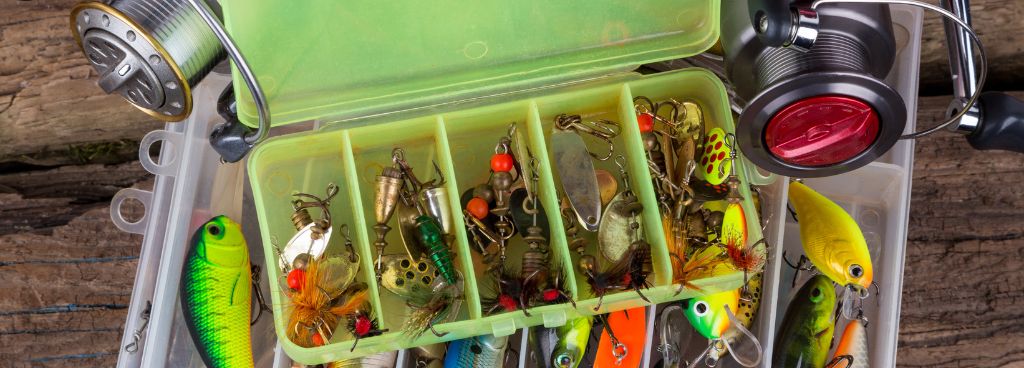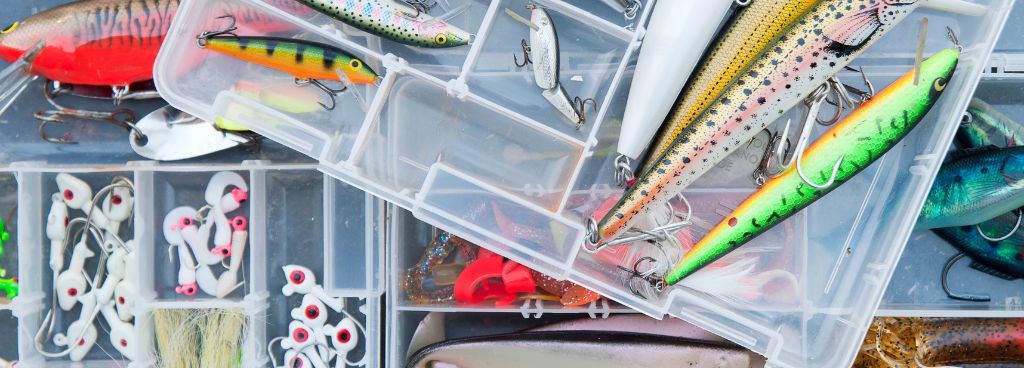Stories Worth Reeling In...
Last Updated on September 29, 2023
When it comes to fishing, having the right tools and equipment can make a world of difference, especially for beginners. A well-stocked fishing tackle box serves as the foundation for a successful and enjoyable fishing experience. Whether you’re casting in tranquil freshwater lakes or venturing into the vastness of the open sea, a well-prepared tackle box is your gateway to a world of angling possibilities.
Stay tuned as we dive into the world of fishing tackle boxes, exploring the must-have gear, organizing tips, budget-friendly options, and much more. Let’s ensure you’re well-prepared to tackle any fishing challenge that comes your way.
Table of Contents
A tackle box is more than just a storage container for fishing gear—it’s an essential companion that keeps your equipment organized and easily accessible. Designed specifically for anglers, a tackle box serves as a centralized hub for your fishing essentials, including hooks, lures, sinkers, lines, and various accessories. With a well-organized tackle box, you can focus on the art of fishing rather than rummaging through a jumbled mess of gear.
From traditional hard-shell tackle boxes to soft-sided tackle bags, each type offers unique features and benefits. Hard-shell tackle boxes, typically made of durable plastic or metal, provide excellent protection for your gear and are ideal for anglers who prefer a more rigid and structured storage solution.
On the other hand, soft-sided tackle bags offer versatility and portability, with multiple pockets and compartments to accommodate different fishing gear. They are a great choice for anglers who prioritize mobility and flexibility.
When building your starter tackle box, it’s important to include the fundamental fishing gear that will set you up for success on the water. Here are the essentials you should consider:
To increase your chances of success, it’s essential to have a diverse selection of lures, baits, and terminal tackles in your tackle box. Here are some key items to consider:
If you are new to shoreline fishing, a backpack-style tackle bag may be beneficial because it will free up your hands. If you’re fishing from a kayak or a boat, however, you’ll need a tackle box or bags with clear trays.
For beginners, it’s important to choose gear options that strike a balance between quality, affordability, and versatility. Here are some recommendations to consider:

Follow these tips to maximize convenience and efficiency. Begin by grouping similar items together, such as hooks, weights, and swivels, to ensure easy access when needed.
Consider using tackle trays or small containers to keep these smaller items organized and prevent them from getting tangled or mixed up. Allocate separate compartments or sections for different types of lures, baits, and terminal tackle, allowing you to quickly find the right gear for the situation at hand. Lastly, keep frequently used items within easy reach, placing them in the most accessible sections of your tackle box.
To optimize your tackle box organization, categorize and arrange your fishing gear based on type, size, and function. Start by grouping items together based on their purpose. For example, dedicate one section for hooks, another for weights, and another for lures. Within each category, further organize items by size and style. You can use labeled compartments or dividers to maintain separation and prevent tangling.
Keeping your tackle box clutter-free and well-organized is crucial for maintaining fishing productivity. Regularly assess the contents of your tackle box and remove any items that are damaged, rusty, or no longer useful. This helps prevent unnecessary clutter and ensures that you only have functional gear at your disposal.
Consider using resealable plastic bags or tackle binders to store soft plastic lures or hooks with leaders, keeping them neatly organized and preventing tangling.

Building a well-equipped tackle box doesn’t have to be an expensive endeavor. As a beginner angler, there are several tips you can follow to create a functional tackle box while staying within your budget. First, prioritize the essential fishing gear and accessories that you’ll need for your specific fishing goals. Also, consider investing in multipurpose items that can serve multiple functions, eliminating the need for separate specialized gear.
While quality is important, there are often cost-effective alternatives available that provide good performance without breaking the bank. Look for fishing gear and accessories from reputable brands that offer budget-friendly options. Online research, customer reviews, and recommendations from fellow anglers can help you identify such cost-effective alternatives.
Saving money while building your tackle box is possible by taking advantage of deals, discounts, and second-hand equipment. Keep an eye out for seasonal sales, clearance events, and promotions at fishing tackle stores or online retailers.
Starter tackle boxes are usually budget-friendly, ranging from $10 to $40, depending on the brand, size, and features.
Some starter tackle boxes are versatile and suitable for both freshwater and saltwater fishing. However, it’s essential to rinse and maintain your gear if you switch between environments.
I encourage you to take the information provided in this guide and create your own customized tackle box tailored to your fishing preferences. Remember to assess your fishing goals, prioritize the essential gear, and organize your tackle box in a way that suits your fishing style.
By doing so, you’ll have a well-equipped tackle box that empowers you to tackle various fishing situations with confidence.
Remember, fishing is a lifelong pursuit, and your tackle box will evolve over time as you gain experience and discover new techniques.
Stay curious, keep learning, and enjoy the exciting world of fishing. Tight lines and happy angling!